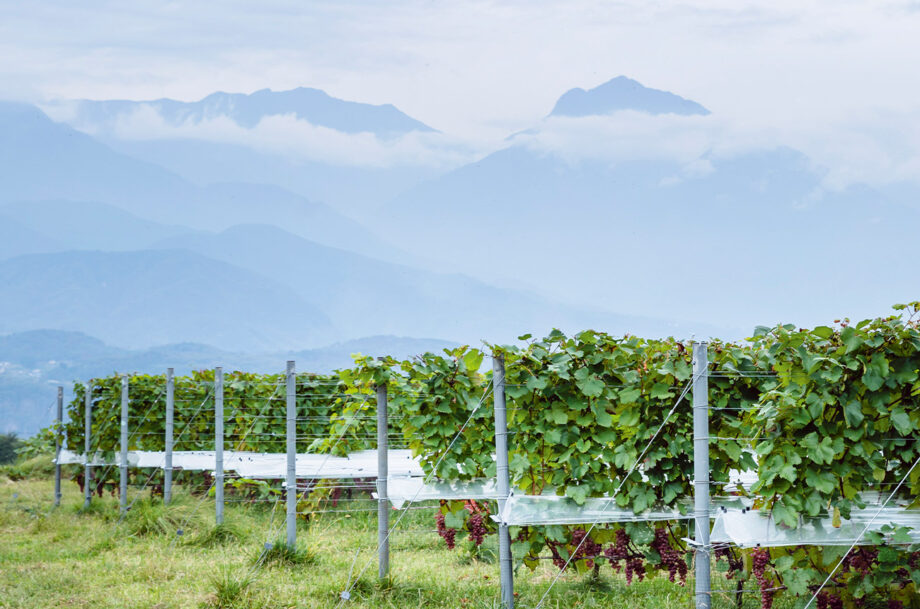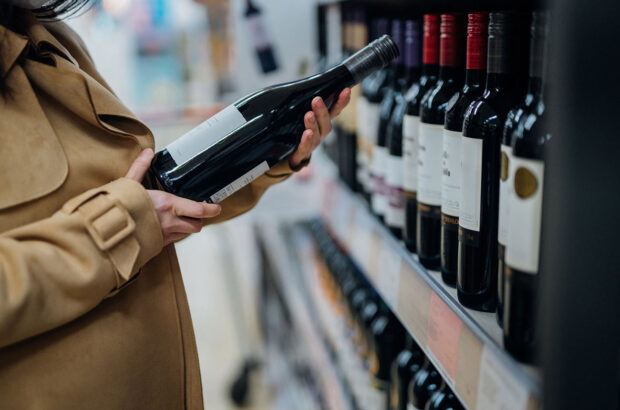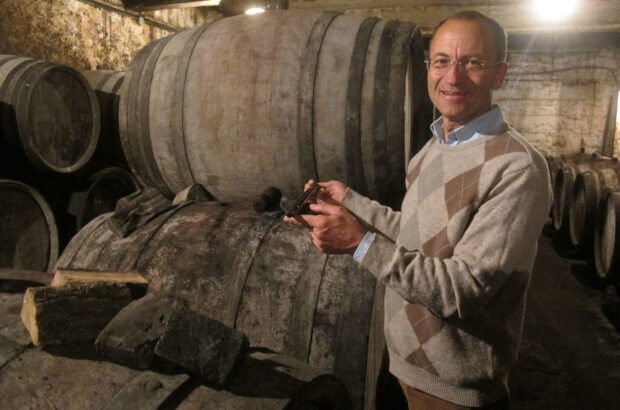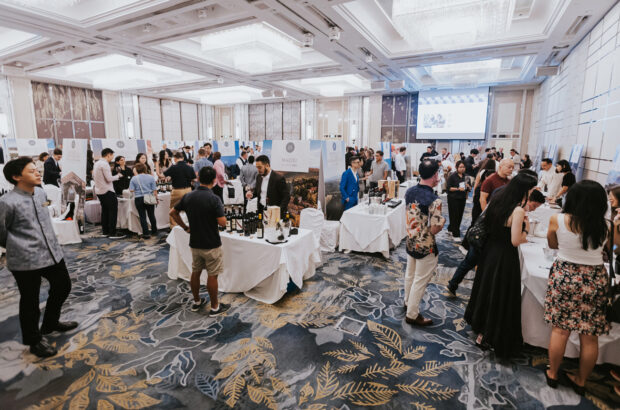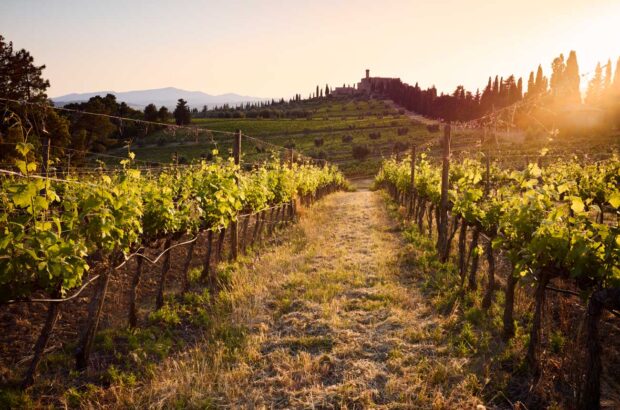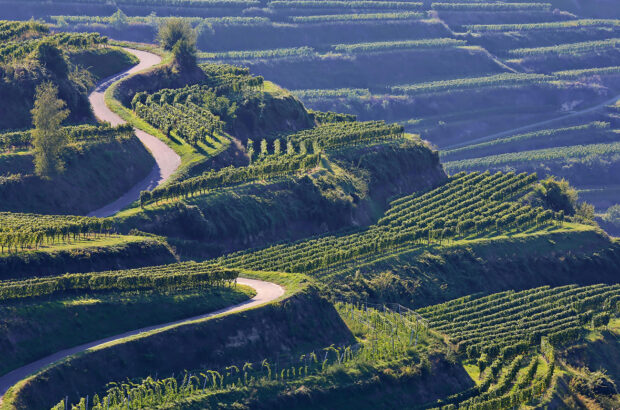In the foothills of the majestic Mount Fuji lie the vineyards of the Yamanashi prefecture, the home to the unique Koshu grape variety, Japan’s oldest. Wineries in the region are skilfully producing oustanding wines that are gaining international acclaim and Koshu became the first Japanese wine to win Best in Show at the Decanter World Wine Awards in 2024. Here, we explore nine Koshu wineries and their stories.
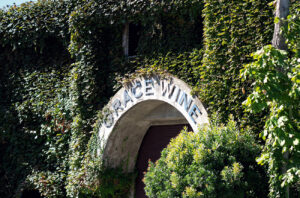
Grace Wine was established in 1923 in Katsunuma. Image supplied by Koshu of Japan.
Grace Wine
With Ayana Misawa at the helm, the winery’s first female CEO, of this century-old family winery, the quest is to produce ageworthy Koshu wines.
You’ll see many faces of Koshu in Yamanashi – some citrusy and mint-fresh, others more textured, with stone fruits and gentle bitterness. But when you encounter a Koshu that transcends a decade – exuding acacia honey, chamomile-scented yellow fruit, its palate still lively, finishing with purity, ripeness, and depth – you realise this indigenous variety deserves more serious attention.
Such is the case with the 2013 Cuvée Misawa Koshu (now ‘Koshu Misawa Vineyard’), from the family’s breezy volcanic Akeno vineyard at 700 metres altitude. Shigekazu Misawa, fourth-generation owner of Grace Wine, was among the first in the region to trial Vertical Shoot Positioning (VSP) on Koshu in the 1990s – moving away from the traditional pergola to better manage vigour and concentrate flavour. In 2002, he pioneered plantings in Akeno – one of the sunniest spots in Japan – with Koshu and international varieties trained in VSP.
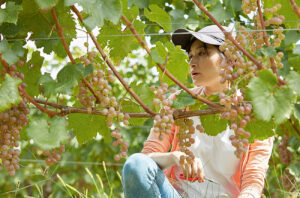
Fifth-generation winemaker Ayana Misawa, Grace Wine’s head of viticulture and oenology. Image supplied by Koshu of Japan.
Since 2008, the torch has been passed to his daughter Ayana Misawa – the first woman to lead the century-old family estate. Trained in France and South Africa, Ayana guided Grace Wine to become the first Japanese winery to win a Gold medal at Decanter Awards. With a keen eye, she seeks to express nuanced Koshu from vineyards in Akeno and Kayagatake to the northwest, and Toriibira and Hishiyama to the northeast of the Kofu Basin, all between 400 and 700 metres altitude.
With the Akeno site partially certified organic, Ayana continues her quest to produce age-worthy ‘super Koshu’ while exploring its potential for elegant reds, especially Cabernet Franc – which already impresses with ethereal ripeness and silky tannins. Her traditional method sparkling Chardonnay is equally compelling.
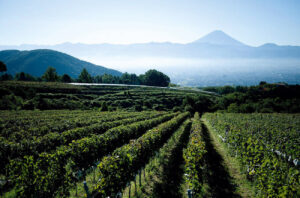
Tomi no Oka Winery is trialling a vertical shoot positioning (VSP) system. Image supplied by Koshu of Japan.
Suntory Tomi no Oka
The unforgettable view of Mount Fuji from the terrace of this winery is something to behold – and so is its DWWA 2024 Best-in-Show-winner.
If you arrive at Tomi no Oka on a sunny day, take in the magnificent view from the terrace – the whole of the Kofu Basin stretches out before you, backed by the towering Minami Alps, the Yatsugatake Mountains and, tallest of them all, Mount Fuji. It is indeed ‘a hill of views’ (tomi no oka) that’s well worth the climb. Perched between Kofu and Nirasaki at 400m-600m altitude, the site forms part of the origin story of its owner, Suntory, which took over the estate in 1936.

Tomi no Oka Winery’s vineyard team. Image supplied by Koshu of Japan.
Today, 25ha of the vast 150ha property is planted to a mix of indigenous and international varieties across 50 blocks mapped by meticulous microclimate analysis. In recent years, rising night-time temperatures in the Kofu Basin have made it harder for grapes to retain acidity, develop flavour and set colour – particularly in red varieties. To tackle this challenge, the estate has been trialling a new pruning method since 2021 with the University of Yamanashi: trimming the tips of early shoots to encourage fruit set on secondary shoots, delaying ripening by more than a month.
Tomi Red, the estate’s premium Bordeaux blend, has also evolved over the past decade. The proportion of Cabernet Sauvignon and Merlot has been scaled back in favour of Petit Verdot – raised to 54% in the splendid 2023 vintage, which exudes floral lift and effortless concentration. Don’t miss the pergola-trained Koshu bottlings, especially Tomi Koshu – the 2022 was named a Best in Show at DWWA 2024 for its exceptional ripeness and slender, elegant palate (see below) – and the latest release, the 2023 vintage, shows great promise too.
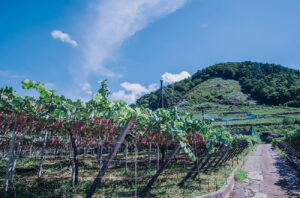
Kurambon Wine’s Katsunuma winery was established in 1913. Image supplied by Koshu of Japan.
Kurambon Wine
Deeply committed to nature and sustainability, this family-owned winery is working its magic with both Koshu and European varieties.
When visiting Kurambon – the Nozawa family’s beautifully preserved 140-year-old traditional house in the Iwai district of Katsunuma – be sure to look for the small penthouse at the top, once used for rearing silkworms to produce silk. Although Takahiko Nozawa was born into a winemaking family with roots dating back to 1913, it was a stay with a host family in Provence that truly sparked his love for wine. He went on to study oenology in Beaune and Burgundy before returning home to take over the family business.
In 2007, he began converting his own 2ha of vineyards to organic farming (although they are not yet certified). Inspired by a visit to Domaine de Souch in Jurançon, he also adopted a no-ploughing approach to enhance biodiversity and promote healthy cover crops. In 2014, in a nod to his commitment to nature and sustainability, Nozawa renamed the winery Kurambon, taking its name from a children’s story by renowned author Kenji Miyazawa.
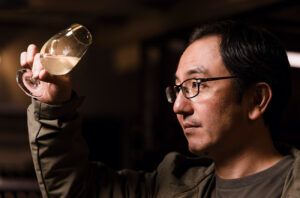
Kurambon Wine’soenologist and owner, Takahiko Nozawa. Image supplied by Koshu of Japan.
Just a short walk from the family home lies the Shichihyo Chibatake site, now replanted with VSP-trained European varieties including Tannat, Viognier and Albariño. From here, you can also glimpse the winery’s Koshu vines, still grown in traditional pergolas, more than 400m up on the famed, southwest-facing Toriibira slopes.
For entry-level delights, try Kurambon’s crisp, zesty Koshu and its juicy, food-friendly Muscat Bailey A Rosé. For intricacy and serious depth, Nozawa’s N Koshu (sourced solely from Toriibira) and N Blanc (from Shichihyo Chibatake) – both wild-yeast fermented in barrel, barrel-aged and bottled unfiltered – are not to be missed.
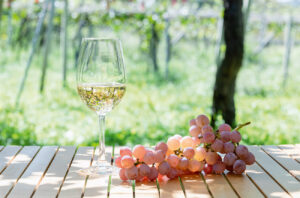
Family-owned Lumière has operated in Yamanashi prefecture since 1885. Image supplied by Koshu of Japan.
Lumière
At one of the oldest wineries in Japan, Shigeki Kida is a pioneer in traditional-method sparkling wines.
Founded in 1885 as Furiya Winery, Lumière is one of the oldest wineries in Japan. A testament to its heritage is its historic ishigura (stone fermentation tanks) – the first of their kind in the country, built in 1901 and now recognised as National Tangible Cultural Property. One of these tanks is still in use today to produce the highly sought-after Ishigura Muscat Bailey A.
The fourth-generation owner, Toshihiko Tsukamoto, was a pioneer in communicating the quality of Japanese wine to the world. Today’s owner, fifth generation Shigeki Kida, embraces innovation through diverse Koshu winemaking styles – including sur lie ageing and barrel fermentation – and has pioneered traditional-method sparkling wines in Japan since 2008. From cherry blossom viewing to autumn events, a variety of activities take place throughout the year at the cellar door – converted from the house where the founder and his family once lived.

Lumière president and CEO Shigeki Kida. Image supplied by Koshu of Japan.
Don’t miss the breathtaking view from just a few steps away, where the vast Koshu pergolas stretch out toward the distant Minami Alps. In addition to Zelkova, a restaurant serving ‘Yamanashi French’ cuisine made with local ingredients, the shop invites visitors to explore an extensive range of wines – notably its acclaimed sparklings (including Orangé, a skin-contact Koshu made using carbonic maceration for brighter fruit) and a unique lineup of the American hybrid Delaware in a range of styles, from dessert wines to sparklings. Named with the Kanji for ‘Lumière’, Hikari Koshu (Barrel Fermentation) is a must-try: winning a Platinum medal at DWWA 2021, it is from Lumière’s own sites in Fuefuki, grown without ploughing, insecticides or fertilisers, to promote biodiversity.
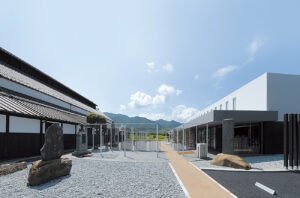
Established in 1870, Château Mercian is the oldest winery in Japan. Image supplied by Koshu of Japan.
Château Mercian
Owned by the Kirin group, this winery celebrates the different styles of Koshu with forward-thinking methods and industry-leading practices.
Modern winemaking in Japan began in 1877, when the country’s first private wine company, Dai-Nihon Yamanashi Budoushu-Gaisha (‘Japan Yamanashi Wine Company’), sent two young employees, Masanari Takano and Ryuken Tsuchiya, to study winemaking in France – a journey that would shape the future of Japanese wine. The descendants of these two pioneers, now Koshu growers, still work with today’s Château Mercian.
Staying true to its roots, Château Mercian has led the way in exploring the many expressions of the indigenous Koshu grape. It was the first to release a sur lie expression (in 1984); pioneered skin contact with 2003’s Gris de Gris; and launched the citrusy, fresh Kiiroka Koshu in 2005 – developed through aroma compound analysis in collaboration with Université Bordeaux II.
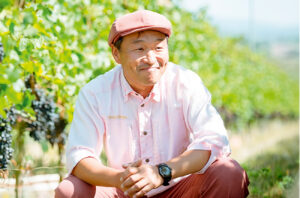
Hironori Kobayashi, head winemaker and general manager at Château Mercian. Image supplied by Koshu of Japan.
The single-vineyard Iwade Koshu Cuvée Ueno is the latest evolution of the Kiiroka style. While working closely with contract growers (who supply 75% of its grapes), Château Mercian has expanded beyond Yamanashi, planting international varieties in the Fukushima, Nagano and Akita Prefectures and establishing wineries in Kikyougahara and Mariko within Nagano. From 1998, consultancy from the late Paul Pontallier of Château Margaux refined its red wines, particularly those from Nagano, including the sophisticated Bordeaux blend Mariko Omnis and the poised Kikyougahara Merlot.
Always looking ahead, the producer is already adapting to the warming climate by planting higher and further north while trialling warm-climate European varieties Syrah, Tannat and Tempranillo. One highlight is the Kamoidera Syrah, grown at 300m in Yamanashi: its Pinot-like elegance and ethereal structure are worth attention.
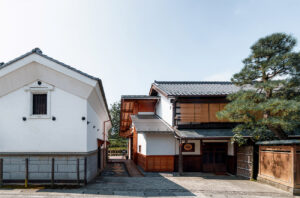
Katsunuma Jyozo’s family-run winery is in the heart of Katsunuma. Image supplied by Koshu of Japan.
Katsunuma Jozo (Aruga Branca Wine)
This winery, run by a father and his three sons, was one of the first Japanese producers to export to the EU – and continues to lead the way.
First established in 1937 as a side project of a silk farm, Katsunuma Jozo is a classic family winery. Third-generation owner Yuji Aruga runs the show, while his three sons handle the day-to-day: Hirotaka, the eldest, trained in Burgundy and leads winemaking; Jun handles marketing; and Sho, the youngest, manages the vineyards.
Today, winemaking has moved from its original 150-year-old home (now a Cultural Heritage Site and museum) although there are plans to return. The winery uses equipment acquired from the Asahi Group after it ceased winemaking in the early 2000s. The brand name Aruga Branca (‘white’ in Portuguese) reflects the producer’s commitment to Koshu, sourced via strict field selection from 70ha of vineyards, 10% of which they own. Through a partnership with Bernard Magrez of Château Pape Clément, Katsunuma Jozo became one of the first Japanese producers to export to the EU.
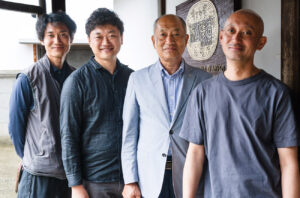
From left: Sho, Jun, Yuji and Hirotaka Aruga. Image supplied by Koshu of Japan.
Its most distinctive bottling has to be Issehara, from a single 2ha vineyard on the sandy floodplain of the Kanegawa river. An early mid-September harvest and well-drained soils yield a Koshu with surprisingly expressive aromatics: rosemary, asparagus and a whisper of passion fruit. Another innovation is Pipa, a dry Koshu made by partially freezing the juice to concentrate flavour (much like in ice wine), before fermenting and ageing in 10% new oak.
The winery’s stunning restaurant, Kaze (‘breeze’), is designed in the style of a neo-Gothic chapel, inspired by Japan’s oldest Christian church, Oura in Nagasaki. Sit at dusk with a glass of Clareza (a floral, rounded sur-lie Koshu), accompanied by live piano, and watch the sky shift in colour through the lancet-arched windows.
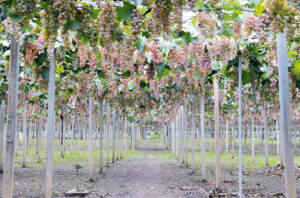
Manns Wines’ Katsunuma winery was established in 1962. Image supplied by Koshu of Japan.
Manns Wines
Established by the Kikkoman group ahead of the 1964 Tokyo Olympics, Manns produces wines often poured at diplomatic occasions and prestigious state banquets.
In 1962, two years before the Tokyo Olympics, food manufacturing giant Kikkoman (perhaps best known in the UK for its soy sauce) established a winery in Katsunuma, with the goal of making Japanese wines that could stand alongside international benchmarks. The winery was named Manns, a nod to both its founding company and ‘manna’ – the miraculous bread from heaven mentioned in the Bible – with its logo reflecting the ample sunshine of the region.
Mainly sourcing grapes from contracted growers near the winery and co-operatives across the prefecture, Manns Wines has become a prominent Koshu producer in Yamanashi. It is exploring international techniques – most recently the Charmat method, producing a wide spectrum of affordable sparkling Koshus with vibrant fruit profiles. Among its rich everyday selection, the Brut edition of Kobo-no-awa (‘bubbles from yeast’) Koshu refreshes with blossom and peppery mint. Try the Koshu GI Yamanashi for a clean, rounded expression, or the Muscat Bailey A from the premium Solaris range for a more exotic, herb-spiced take on the region’s key red variety.

From left: viticulturist Fukasawa Hironu, chief winemaker Usami Takashi and assistant winemaker Shibatani Kohei. Image supplied by Koshu of Japan.
Beyond the large-scale Yamanashi estate, Manns Wines also cultivates its own vineyards in Komoro, Nagano Prefecture – a cooler-climate site at 650m altitude, established in 1971 – where it pursues a more boutique, terroir-driven approach. The plantings focus on European varieties, and the winery pioneered a rain-shielding trellis system for VSP-trained vines here, a technique now used by many Japanese producers.
The Solaris range from Komoro – poured at various diplomatic occasions since its launch in 2001 – includes award-winning bottlings of old-vine Chardonnay, Sauvignon Blanc and classic Bordeaux blends.
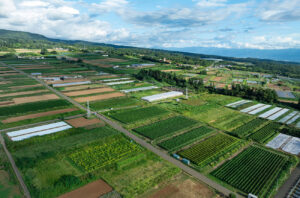
Fujiclair owns two vineyards in Hokuto, in the far northwest of Yamanashi prefecture. Image supplied by Koshu of Japan.
Fujiclair
With its refined winemaking methods, this winery creates a wide variety of wines with no chaptalisation, acidification or filtration, and lower-alcohol styles.
The name, combining Mount Fuji and clair (French for ‘clear’), offers a clue to the producer’s winemaking philosophy. Pursuing a pristine, refined style, Fujiclair employs no chaptalisation (which is common practice in the region), no acidification, no filtration and only wild yeast fermentation for most of its wines. Fujiclair’s flagship Kyoutou Koshu and Ginka Koshu, both only 9% alcohol, perfectly embody this gentle and delicate style.
The premium Momochi range, from the producer’s own vineyard in the volcanic, high-altitude Akeno site in Hokuto, in the northwest of the Kofu Basin, conveys the same ethos with international varieties – notably the peppery, mineral Syrah and the poised, seductive Chardonnay. For everyday enjoyment, there’s also the ‘picnic wine’ Lady Beetle range and the lightly sparkling, cloudy Kurano-oto (‘the sound of fermentation’).
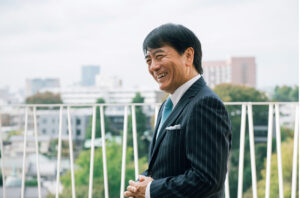
Fujiclair CEO Kanta Sawamura. Image supplied by Koshu of Japan.
To mark its 60th anniversary in 2023, the winery launched an ambitious 40ha project in the Mukawa area (also within Hokuto). Adding to its 0.85ha vineyards in historic Katsunuma and the 2.21ha Akeno site, the Mukawa plantings are set to become one of the largest single vineyards in Japan. The first phase of the project, cultivated using sustainable methods, will focus on producing traditional-method sparkling wines with a regional twist, according to CEO Kanta Sawamura. The plan is to blend the Champagne trio with Koshu and Muscat Bailey A for regional character and brighter fruit. The first vintage is planned for 2032, to be released in 2034.
Visitors to the estate’s Katsunuma winery can enjoy samples at the panoramic cellar door overlooking the traditional winemaking town, with Yamanashi local produce served alongside the wines at the shop.
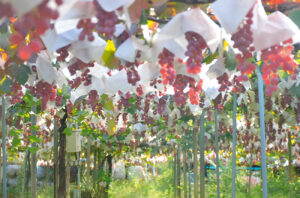
Iwasaki Jozo was founded in 1941 as a cooperative of 130 grape growers. Image supplied by Koshu of Japan.
Iwasaki Jozo
This local cooperative winery is renowned for its quality-driven approach and minimal-intervention winemaking.
Founded as a co-operative in 1941, Iwasaki Jozo works closely with around 130 local grower families, based mostly in Iwai, Katsunuma. The winery is famed for its commitment to quality: not only are its bottles emblazoned with the words honkaku jozo (‘quality-driven winemaking’), but locals even affectionately refer to it as Honjo-san – ‘Mr Quality’.
CEO Soma Shiraishi’s family has managed the winery for six generations. Shiraishi is a plant genetics graduate from the University of Yamanashi with a sharp scientific mind: meet him at the cellar door – also his office – and you’ll immedately sense his energetic curiosity, balanced by a romantic streak revealed by the poetic names he gives his wines.
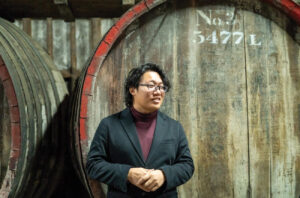
Soma Shiraishi, president and CEO of Iwasaki Jozo. Image supplied by Koshu of Japan.
Shiraishi takes a minimalist approach to managing the winery’s own 2ha of vines, pruning the complicated pergolas himself. He harvests Koshu late to craft a richer, weighted style – most notably in his signature orange Koshu, the skin-fermented Tokiwa-ni-Moyuru (‘eternally aflame’), which combines pristine fruits and textural charm. Traditional earthen walls help with temperature control in the summers, which can reach 40°C, while custom- built sensors at different levels of the tanks track temperature and extraction.
You’ll also spot sake tanks repurposed for red wine, an example of the winery’s hands-on, adaptive approach. Other standouts include the Dry Foudre Aging Koshu, matured in an 80-year-old, 5,000L barrel, as well as the zero-dosage sparkling Koshu, Terroir Iwai Hoshiai-no-Sora (‘Milky Way’). For something more playful, try the Honjyo Collaboration Le Jaja de Jojo – fermented with indigenous yeast, unfiltered and just 8% alcohol – a collaboration with Shiraishi’s flying winemaker friend from France.
Nine Koshu wines to try…

Château Mercian, Iwasaki Koshu, Yamanashi 2023
Hailing from Iwasaki’s clay and gravel soils, and fermented and aged in large, used oak barrels. Fresh golden apple, yuzu and white peach on the nose, with green fruits and yellow citrus zest on the palate. The finish shows tangerine peel and nuts. Alc 12%

Iwasaki Jozo, Château Honjyo Koshu Sur Lie Utatane-wa, Yamanashi 2022
Aged in stainless steel tanks on its lees. Yuzu, melon and hints of savoury cream on the nose, alongside notes of golden apple peel. Batonnage gives the wine a rich, oily mouthfeel and adds nutty depth to the citrus fruits, with touches of red berries. Alc 12.5%

Lumière, Sparkling Koshu, Yamanashi 2021
This zero-dosage sparkling Koshu has seen 20 months of ageing in bottle. Bruised red apple and touches of sweet spices on the nose. Zingy, fresh acidity at (4.7g/l ) adds to brioche, yuzu and green fruits on the palate, leading to a clean, nutty finish. Alc 11%

Fujiclair, Ginka Koshu, Yamanashi 2023
Whole-bunch pressed and fermented with wild yeast, then aged sur lie and bottled without filtration. Aromas and flavours of steamed rice, creamy yuzu and pear drop, alongside hints of osmanthus blossom and a honeyed finish. Alc 9%

Katsunuma Jozo, Aruga Branca Issehara Koshu, Yamanashi 2023
A single-vineyard Koshu sourced from sandy soils, with a smoky, grassy nose of green fruits and gooseberry. Aged in stainless steel tanks, highlighting the saline and mineral qualities of Koshu, with elegant and subtle lime and zest. Clean and refreshing. Alc 12%

Manns, Sparkling Kobo-no-awa Brut Koshu, Yamanashi NV
Flinty stone fruit aromas are joined by some savoury biscuit. Crisp and frosty: 7.2g/L of residual sugar gives the wine a ripe apple palate and a round texture, while solid acidity (5.9g/L) provides a clean finish. Alc 11%

Grace, Koshu Hishiyama Vineyard, Yamanashi 2023
Whole-bunch pressed, fermented and aged in stainless steel. Complex nose of orange oil, yuzu peel and white peach. Savoury, delicate and balanced: green and white fruit with oily texture. Lime and sweet spices lead to melon and umami on the long finish. Alc 11.5%

Kurambon Wine, N Koshu, Yamanashi 2023
Produced from organically grown grapes and fermented with wild yeast, partially in used French oak and bottled unfiltered. This wine has a creamy nose of bruised red apple and blood orange. On the palate is sweet apple peel, yuzu and crushed nuts with an umami finish. Alc 12%

Suntory, From Farm Tomi Koshu, Yamanashi 2022
Almost pointilliste: pale silver-gold in colour, with whispered tropical-fruit scents and a slender, darting flavour which resumes some of those tropical aromatic notes but now bonds them to an apple- and-grape freshness. It’s low in alcohol and both quenching and refined. Alc 12%



